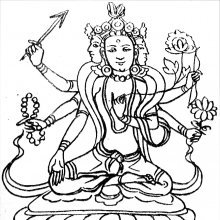Shadbhujasitatara, Ṣaḍbhujasitatārā, Shadbhuja-sitatara: 1 definition
Introduction:
Shadbhujasitatara means something in Buddhism, Pali. If you want to know the exact meaning, history, etymology or English translation of this term then check out the descriptions on this page. Add your comment or reference to a book if you want to contribute to this summary article.
The Sanskrit term Ṣaḍbhujasitatārā can be transliterated into English as Sadbhujasitatara or Shadbhujasitatara, using the IAST transliteration scheme (?).
Images (photo gallery)
In Buddhism
Tibetan Buddhism (Vajrayana or tantric Buddhism)
Source: archive.org: The Indian Buddhist IconographyṢaḍbhujasitatārā (षड्भुजसिततारा) or simply Sitatārā refers to one of the various emanations of Amoghasiddhi, as mentioned in the 5th-century Sādhanamālā (a collection of sādhana texts that contain detailed instructions for rituals).—Her Colour is white; her Āsana is the ardhaparyaṅka; she has three faces and six arms.—There are many Sādhanas for Sitatārās, or the Tārās of white colour but in none of them are they mentioned as bearing the image of Amoghasiddhi on their crowns. It is only in this case that the image of the Dhyāni Buddha is expressly mentioned.
The Dhyāna (meditation instructions) of Ṣaḍbhujasitatārā described in the Sādhanamālā as follows:—
“The worshipper should conceive himself as Sitatārā, who is three-faced, and six-armed. Her right face is yellow and the left blue in colour, and the faces are endowed with three eyes each. Her three right hands show the varada-mudrā, the rosary and the arrow, and the three left carry the utpala, the lotus and the bow. She sits in the ardhaparyaṅka attitude, sits on and shines like the moon, and bears the effigy of Amoghasiddhi on her crown of matted hair. Her head is embellished by five severed heads and the crescent moon. She is decked in many ornaments, is twice eight years old, and resides in the midst of the eight cremation grounds. Thus meditating...”

Tibetan Buddhism includes schools such as Nyingma, Kadampa, Kagyu and Gelug. Their primary canon of literature is divided in two broad categories: The Kangyur, which consists of Buddha’s words, and the Tengyur, which includes commentaries from various sources. Esotericism and tantra techniques (vajrayāna) are collected indepently.
See also (Relevant definitions)
Relevant text
Search found 1 books and stories containing Shadbhujasitatara, Ṣaḍbhujasitatārā, Shadbhuja-sitatara, Ṣaḍbhuja-sitatārā, Sadbhujasitatara, Sadbhuja-sitatara; (plurals include: Shadbhujasitataras, Ṣaḍbhujasitatārās, sitataras, sitatārās, Sadbhujasitataras). You can also click to the full overview containing English textual excerpts. Below are direct links for the most relevant articles:
The Indian Buddhist Iconography (by Benoytosh Bhattachacharyya)
